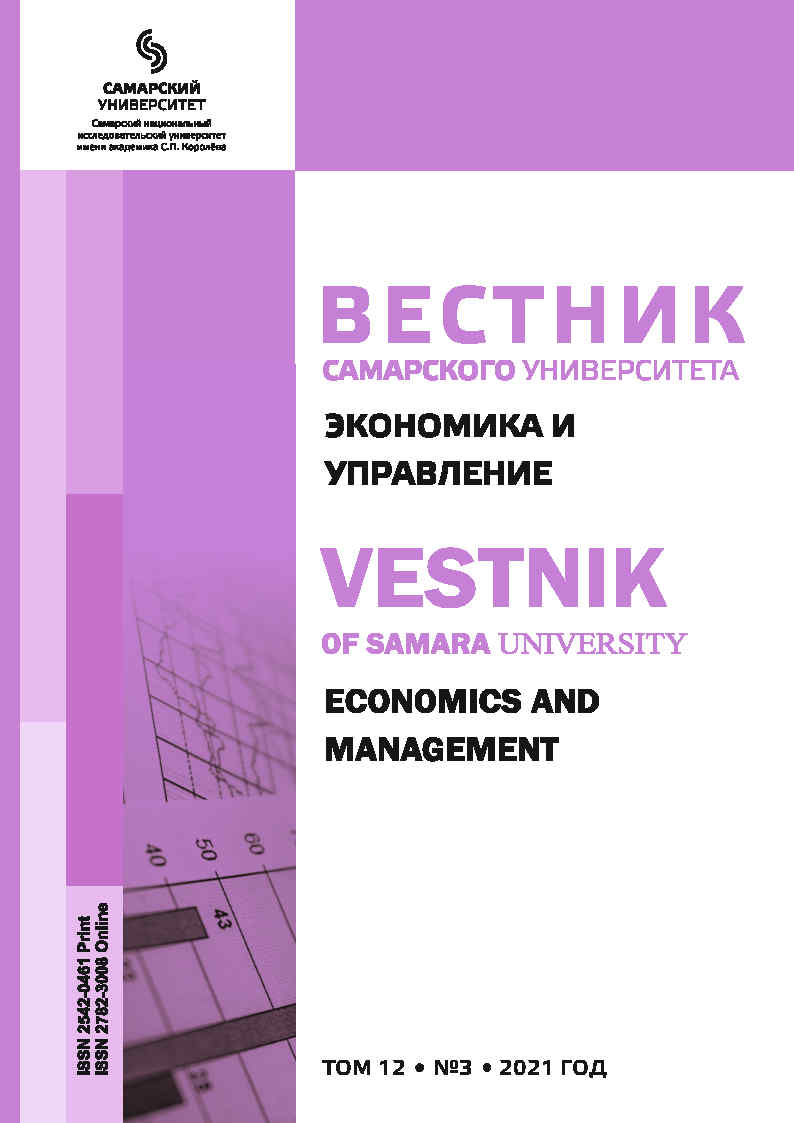Vector model of error correction in modeling the relationship between bank lending indicators and the growth rates of the Russian economy
- Authors: Ivanov D.Y.1, Tali T.M.1
-
Affiliations:
- Samara National Research University
- Issue: Vol 12, No 3 (2021)
- Pages: 147-154
- Section: MATHEMATICAL AND INSTRUMENTAL METHODS OF ECONOMICS
- URL: https://journals.ssau.ru/eco/article/view/9873
- DOI: https://doi.org/10.18287/2542-0461-2021-12-3-147-154
- ID: 9873
Cite item
Full Text
Abstract
The article discusses the problem of modeling the functional dependence of the volume of loans issued and the growth rate of the Russian economy. The relevance of this study is due to the need to identify the factors affecting the growth of the indicator of real gross domestic product. The analyzed domestic and foreign sources do not provide a single set of factors affecting the growth rate of the national economy, highlighting financial mechanisms, production processes, lending volumes to individuals and legal entities, investment activity, etc. The article notes the problem of the formation of a multifactor model of the influence of various parameters on the indicator of the growth rate of the national economy. The process of modeling the functional dependence of GDP on the elements of the influence vector is complicated by the specifics of statistical data. In order to avoid such problems associated with series cointegration, a vector error correction model was proposed. The model was tested on statistical data of organizations in the banking sector and enterprises of the real sector of the Russian economy. It was revealed that under the existing conditions of organizing the lending process, the banking system works not so much to increase production volumes as to maintain the level of the financial condition of economic entities (maintaining the level of liquidity and increasing financial investments), while not contributing to a change in the overall structure of the Russian economy. The developed vector model of error correction makes it possible to measure deviations from equilibrium and the rate of its recovery, which indicates the greater efficiency of this technique. At the same time, the above results allow us to conclude that in the presence of a positive relationship between the volume of lending and the main indicators, the degree of influence of lending on economic growth is generally insignificant
About the authors
Dmitriy Y. Ivanov
Samara National Research University
Author for correspondence.
Email: ivanov.dyu@ssau.ru
ORCID iD: 0000-0003-0619-9340
Doctor of Economics, professor, head of the Department of Management and Production Organization
Russian Federation, 34, Moskovskoye shosse, SamaraTali Mahdi Mohammed Tali
Samara National Research University
Email: m.economic@mail.ru
postgraduate student
Russian Federation, 34, Moskovskoye shosse, SamaraReferences
- McKinnon R.I. Money and Capital in Economic Development. Washington, DC: Brooking Institution, 1973, 184 p. Available at: https://www.brookings.edu/book/money-and-capital-in-economic-development/.
- Allen D.S., Ndikumana L. Financial Intermediation and Economic Growth in Southern Africa. Journal of African Economies, 2000, no. 9, pp. 132–160. DOI: http://dx.doi.org/10.1093/jae/9.2.132.
- Bencivenga V.R., Smith B.D. Financial Intermediation and Endogenous Growth. The Review of Economic Studies, 1991, no. 58, pp. 195–209. Available at: http://links.jstor.org/sici?sici=0034- 6527%28199104%2958%3A2%3C195%3AFIAEG%3E2.0.CO%3B2-3.
- Goldsmith R.W. Financial Structure and Development. New Haven, CT: Yale University Press, 1969, 561 p.
- Shaw E.S. Financial Deepening in Economic Development. New York: Oxford University Press, 1973, 270 p.
- Schumpeter J.A. The Theory of Economic Development. Harvard Economic Studies, 1911–1912, no. 46, pp. 72–74.
- Gurley J.G., Shaw E.S. Financial Aspects of Economic Development. The American Economic Review, 1955, no. 3, pp. 515–538.
- Andreeva E.G., Sukhova A.N. Economic growth. Models of economic growth. Omsk Scientific Bulletin, 2011, no. 6 (102), pp. 46–50. Available at: https://elibrary.ru/item.asp?id=17942321. (In Russ.)
- Gogin A.A. A multifactor model of economic growth and a forecast for the development of the region in the medium term. Ivanovo, 2013, 15 p. Available at: https://dspace.kpfu.ru/xmlui/bitstream/handle/net/147187/0- 803711.pdf?sequence=-1&isAllowed=y. (In Russ.)
- Giblova N.M. The influence of monetary policy on economic growth in conditions of instability. Banking, 2015, no. 2, pp. 14–20. Available at: http://www.library.fa.ru/files/Giblova.pdf; https://elibrary.ru/ item.asp?id=23098674. (In Russ.)
- Dembilov O.E. The role of monetary policy of the Bank of Russia in the state's economic development. Russian Journal of Entrepreneurship, 2015, vol. 16, no. 20, pp. 3387–3398. DOI: https://doi.org/10.18334/rp.16.20.2009. (In Russ.)
- Orlova C.Yu., Ivanov D.Y. Banking system participants interaction modeling with an allowance for risk. Izvestia of Samara Scientific Center of the Russian Academy of Sciences, 2013, vol. 15, no. 6-4, pp. 1074–1077. Available at: http://www.ssc.smr.ru/media/journals/izvestia/2013/2013_6_1074_1077.pdf; https://elibrary.ru/ item.asp?id=21834487. (In Russ.)
Supplementary files










